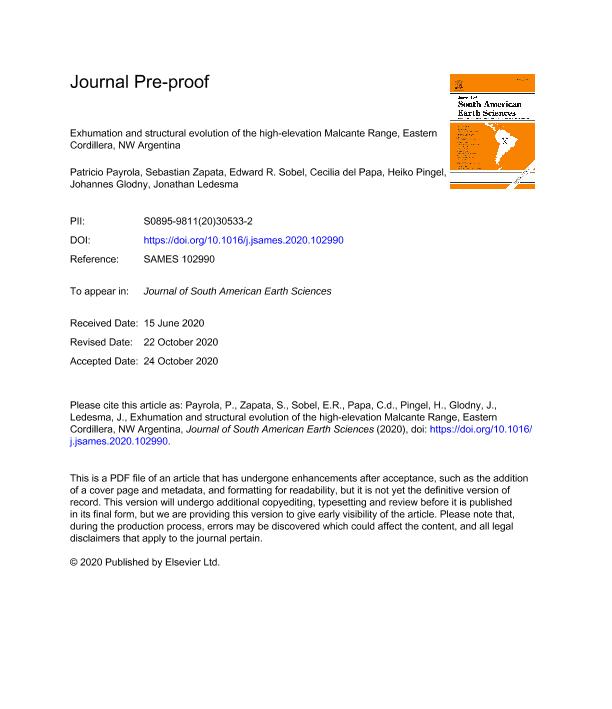Mostrar el registro sencillo del ítem
dc.contributor.author
Payrola Bosio, Patricio Augusto

dc.contributor.author
Zapata, Matias Sebastian

dc.contributor.author
Sobel, Edward Robert

dc.contributor.author
del Papa, Cecilia Eugenia

dc.contributor.author
Pingel, Heiko

dc.contributor.author
Glodny, Johannes

dc.contributor.author
Ledesma, Jonathan Hernán

dc.date.available
2021-09-22T16:37:27Z
dc.date.issued
2021-01
dc.identifier.citation
Payrola Bosio, Patricio Augusto; Zapata, Matias Sebastian; Sobel, Edward Robert; del Papa, Cecilia Eugenia; Pingel, Heiko; et al.; Exhumation and structural evolution of the high-elevation Malcante Range, Eastern Cordillera, NW Argentina; Pergamon-Elsevier Science Ltd; Journal of South American Earth Sciences; 105; 1-2021; 1-44; 102990
dc.identifier.issn
0895-9811
dc.identifier.uri
http://hdl.handle.net/11336/141199
dc.description.abstract
As an integral part of the Eastern Cordillera, the fault-bounded Malcante mountain range (up to 5100 m) in the NW Argentine Andes (ca. 25°S) is located in the transition between the arid Puna Plateau to the west and the humid broken foreland to the east. At this latitude, the topographic gradient of the eastern Andean margin forms an efficient orographic barrier that causes pronounced east–west rainfall and surface-process gradients. In this setting, the Malcante Range is an important, yet poorly studied structural high formed during the Cenozoic topographic growth of the Central Andes. In this study, we combine (a) detailed field observations, (b) a two-dimensional structural reconstruction, (c) apatite fission track and (U–Th-Sm)/He thermochronology of bedrock samples from a vertical transect across the western flank of the Malcante Range, and (d) inverse thermal modelling using QTQt software with the aim of deciphering the exhumation history of this mountain range. Field data indicate the presence of an angular unconformity between Cenozoic foreland deposits and older sedimentary strata, suggesting an initial episode of deformation during the middle-late Eocene, while our thermal model constrains the onset of exhumation at ~10 Ma. We suggest that exhumation was related to the unroofing of the easily erodible sedimentary cover, which prevented significant initial surface uplift. This may have changed as more resilient bedrock was exposed at ~5 Ma according to the thermal model, promoting rapid rock uplift. In combination with published data, our thermochronology allows us to speculate on the existence of a zone of deformation concentrated in the area of the present-day Pasha (24.5°S), Malcante (25°S), and Agua de Castilla (25.4°S) mountain ranges by ca. 10 Ma.
dc.format
application/pdf
dc.language.iso
eng
dc.publisher
Pergamon-Elsevier Science Ltd

dc.rights
info:eu-repo/semantics/openAccess
dc.rights.uri
https://creativecommons.org/licenses/by-nc-nd/2.5/ar/
dc.subject
APATITE (U–TH)/HE
dc.subject
APATITE FISSION TRACK
dc.subject
EASTERN CORDILLERA
dc.subject
MOUNTAIN BUILDING
dc.subject
NW ARGENTINA
dc.subject
THERMOCHRONOLOGY
dc.subject.classification
Geología

dc.subject.classification
Ciencias de la Tierra y relacionadas con el Medio Ambiente

dc.subject.classification
CIENCIAS NATURALES Y EXACTAS

dc.title
Exhumation and structural evolution of the high-elevation Malcante Range, Eastern Cordillera, NW Argentina
dc.type
info:eu-repo/semantics/article
dc.type
info:ar-repo/semantics/artículo
dc.type
info:eu-repo/semantics/publishedVersion
dc.date.updated
2021-04-28T20:37:20Z
dc.journal.volume
105
dc.journal.pagination
1-44; 102990
dc.journal.pais
Estados Unidos

dc.description.fil
Fil: Payrola Bosio, Patricio Augusto. Consejo Nacional de Investigaciones Científicas y Técnicas. Centro Científico Tecnológico Conicet - Salta. Instituto de Bio y Geociencias del NOA. Universidad Nacional de Salta. Facultad de Ciencias Naturales. Museo de Ciencias Naturales. Instituto de Bio y Geociencias del NOA; Argentina
dc.description.fil
Fil: Zapata, Matias Sebastian. Smithsonian Tropical Research Institute; Panamá. University of Missouri; Estados Unidos
dc.description.fil
Fil: Sobel, Edward Robert. Universitat Potsdam. Mathematisch Nautrwissenschaften Fakultat. Institut für Geowissenschaften; Alemania
dc.description.fil
Fil: del Papa, Cecilia Eugenia. Consejo Nacional de Investigaciones Científicas y Técnicas. Centro Científico Tecnológico Conicet - Córdoba. Centro de Investigaciones en Ciencias de la Tierra. Universidad Nacional de Córdoba. Facultad de Ciencias Exactas Físicas y Naturales. Centro de Investigaciones en Ciencias de la Tierra; Argentina
dc.description.fil
Fil: Pingel, Heiko. Universitat Potsdam. Mathematisch Nautrwissenschaften Fakultat. Institut für Geowissenschaften; Alemania
dc.description.fil
Fil: Glodny, Johannes. German Research Centre for Geosciences; Alemania
dc.description.fil
Fil: Ledesma, Jonathan Hernán. Consejo Nacional de Investigaciones Científicas y Técnicas. Centro Científico Tecnológico Conicet - Córdoba. Centro de Investigaciones en Ciencias de la Tierra. Universidad Nacional de Córdoba. Facultad de Ciencias Exactas Físicas y Naturales. Centro de Investigaciones en Ciencias de la Tierra; Argentina
dc.journal.title
Journal of South American Earth Sciences

dc.relation.alternativeid
info:eu-repo/semantics/altIdentifier/doi/http://dx.doi.org/10.1016/j.jsames.2020.102990
dc.relation.alternativeid
info:eu-repo/semantics/altIdentifier/url/https://www.sciencedirect.com/science/article/abs/pii/S0895981120305332
Archivos asociados
